
Zornia is a cosmopolitan genus of herbs from the legume family Fabaceae. It was recently assigned to the informal monophyletic Adesmia clade of the Dalbergieae.

Nuphar lutea, the yellow water-lily, brandy-bottle, or spadderdock, is an aquatic plant of the family Nymphaeaceae, native to northern temperate and some subtropical regions of Europe, northwest Africa, and western Asia. This species was used as a food source and in medicinal practices from prehistoric times with potential research and medical applications going forward.
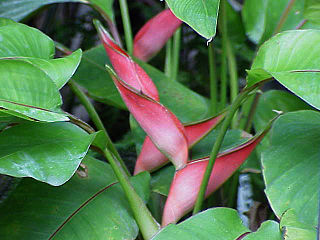
Heliconia stricta is a species of flowering plant in the family Heliconiaceae. It is native to Brazil, Colombia, Venezuela, Ecuador, Peru, Bolivia, Guyana, Suriname, reproducing by seeds and by underground rhizomes. It is reportedly naturalized in Cuba and Puerto Rico, and cultivated as an ornamental in many other warm regions. The young leaves and bracts retain water, forming pools called phytotelmata, which provide habitat for diverse invertebrates.
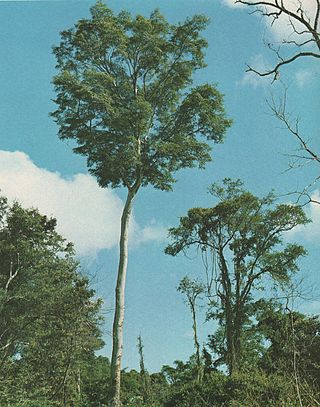
Amburana cearensis is a species of timber tree in the family Fabaceae. This plant is native to Argentina, Bolivia, Brazil, Paraguay, and Peru. It is threatened by habitat loss.
Gustavia longepetiolata is a species of woody plant in the family Lecythidaceae. It is found only in Brazil. It is threatened by habitat loss.
Bonnetia holostyla is a species of flowering plant in the family Bonnetiaceae. It is found only in Colombia.
Manilkara paraensis is a species of plant in the family Sapotaceae. It is endemic to Brazil, where it is threatened by habitat loss.
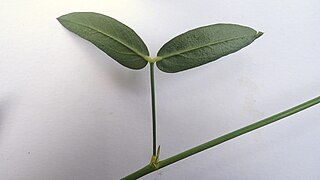
Zornia latifolia is a species of flowering plant in the legume family, Fabaceae. It is native to South America. Its distribution may extend into Central and North America. It is also known as a naturalized species in tropical western Africa. The plant is known commonly as maconha brava.

Dalbergia cearensis, with common names Brazilian kingwood, kingwood, Bois de Violette, and violetwood, is a small tree endemic to Brazil.

Tillandsia fendleri is a species of flowering plant in the family Bromeliaceae. It is epiphytic. This species is native to the West Indies and South America.

The tribe Dalbergieae is an early-branching clade within the flowering plant subfamily Faboideae. Within that subfamily, it belongs to an unranked clade called the dalbergioids. It was recently revised to include many genera formerly placed in tribes Adesmieae and Aeschynomeneae and to be included in a monophyletic group informally known as the dalbergioids sensu lato. The members of this tribe have a distinctive root nodule morphology, often referred to as an "aeschynomenoid" or "dalbergioid" nodule.

Syagrus cearensis is a natural palm endemic to Brazil.
C. cearensis may refer to:
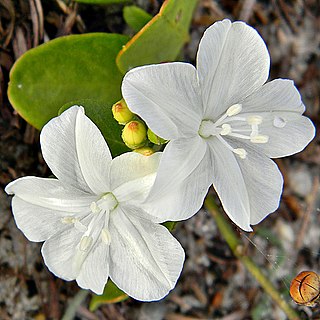
Jacquemontia is a genus of plants in the morning glory family Convolvulaceae. Species in this genus are commonly known as clustervine.
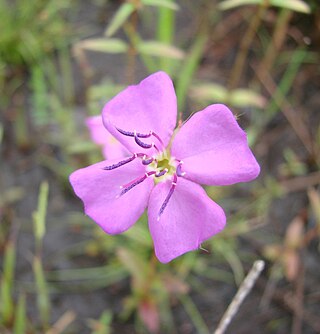
Pterolepis is a genus of flowering plant in the family Melastomataceae. Within Melastomataceae, it forms a clade with genus Pterogastra. Pterolepis contains some fifteen species, all of which are found in the Neotropical geographic realmm. Most species are concentrated in Brazil, with a few others across Central and South America.
Zornia glabra is a herb species found in South America and native to French Guiana, Guyana, Suriname and Brazil.

Zornia dyctiocarpa is a prostrate or decumbent perennial plant to 30 cm tall. The specific epithet dyctiocarpa is derived from the Greek language, and refers to the significantly veined pods. A widespread plant, found in grassland and open forest.

Magoniella is a monotypic genus of flowering plants belonging to the family Polygonaceae. The only species is Magoniella obidensis. Its native range is Costa Rica, Venezuela to Brazil and Bolivia.
Zornia glochidiata is a leguminous herb of the Fabaceae family, it is widely distributed in the Sahel regions of West Africa. It is reputed to be an important forage plant in the region.











